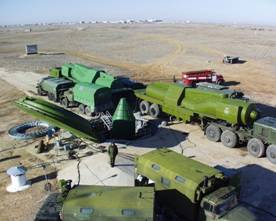
«Strela» LV launch, Baikonur , 05.12.2003
One of the basic elements of the “Pragmatic space” program launched by the company is building and exploitation of “Strela” rocket space complex using the technological equipment and mechanisms dismantled from the objects belonging to Strategic Missile Forces and from retired RS-18 ICBM. “Strela” LV was derived from UR-100N Ủ̉Kh (RS-18B) ICBM, developed by the company in the middle 1970s and commissioned in 1980. The missile complexes UR-100N Ủ̉Kh are still in service with the Army being one of the most threatening and effective means of nuclear deterrence. The high reliability and combat readiness of the complexes are verified by their long-term exploitation.
The principal concept implemented in this project is maintenance of the maximum succession of “Strela” rocket complex with the basic complex having high reliability indices. Employment of “Strela” complex will allow to conduct the cost effective launches of small spacecraft into the orbits of different altitudes and inclinations.
Recently the solutions were approved for extending the service life of the basic complexes with the possibility to conduct launches in the next decades. The program of extending the RS-18 ICBM service life is ensured by annual launches and flaw detection of the missiles on duty for a long time.

“Strela” LV is launched from Baikonur cosmodrome (Kazakhstan , 45.6 deg. North, 63.3 deg. East). To prepare Customers' spacecraft for launch on “Strela” LV from Baikonur, a special technical position has been arranged in one of the integration building at cosmodrome, with all necessary equipment for launch preparation.
The power budget of “Strela” LV allows to use Baikonur cosmodrome for launching S/C of up to 1500 kg into low orbits with the inclinations close to 63 deg. It is possible to change the inclination within few degrees due to S/C lateral maneuver in the ascent trajectory and it depends on the orbit altitude and payload weight. If required, the impact zones can be located for the LV separated parts, when S/C is launched at the other inclinations. JSC MIC Mashinostroyenia” is ready to conclude contracts for commercial launches of “Strela” LV from Baikonur cosmodrome.
The first demonstration launch of “Strela” LV from Baikonur cosmodrome was performed on December 5, 2003 . The S/C mass-inertia dummy of (978 kg) was injected into the orbit onboard “Strela” LV at inclination of 67.067 deg, apogee of 458.8 km, perigee of 458 km.
|
|
| Installation of the space head section of «Strela» LV into the silo launcher |
Instrumentation section with the spacecraft model on the tilter |
 |
 |
| «Strela» LV ready for launch in the silo | «Strela» LV Fueling |
 |
«Strela» launch vehicle basic performance“Strela” LV is a liquid propellant two-stage light class launch vehicle with the modular/ instrumentation section, which operates as a booster. LV was designed based upon the retired ICBM RS-18. The purpose of “Strela” LV is to deliver the payloads up to 2000 kg to LEO or upper atmospheric layers of the Earth. The LV is made according to tandem scheme with the transverse subdivision of stages, with the take-off weight of about 105 tons, the maximum length of 28.27 m and diameter of 2.5 m. Mechanism and instrument sectionThe mechanism and instrument section (MIS) is designed to house the autonomous onboard control system with the onboard power source and propulsion plant, which can be used in the boost phase immediately after separation from the 2-nd stage booster or in the apogee of ascent trajectory. Thus, MIS plays the role of a single-action booster. Space head sections (SHS)The “Strela” LV can be equipped with space head sections of one of two types (SHS-1 or SHS-2) different in domes and as a result with different dimension of payload location area. In all cases the SHS consists of:
|
 The instrumentation compartment (MIC) is used to house the TM and trajectory measurement systems. In addition, the onboard power supply sources and the propulsion plant are located in the compartment for the post-boost stabilization in three channels. The intermediate stage is intended for mounting the nose dome.
The instrumentation compartment (MIC) is used to house the TM and trajectory measurement systems. In addition, the onboard power supply sources and the propulsion plant are located in the compartment for the post-boost stabilization in three channels. The intermediate stage is intended for mounting the nose dome.
The nose domes consist of two halves made of metal sheet with the longitudinal and lateral ribs.
The nose dome jettison altitude depends upon the S/C orbit altitude, constraints of the thermal effect on the S/C, and it is within 110...150 km.
To reduce the heat flow on the S/C during boost phase, the dome inner surface is covered with thermal insulating material.
 |
The ultimate errors of the orbit parameters ensured by “Strela” LV during injection within the specified range of altitudes and inclinations are as follows:
|

There are two schemes of the spacecraft injection into LEO:
• Injection into the low orbits by continuous scheme: the MIS propulsion plant (acting as a booster) is fired immediately after separation from the 2-nd booster stage.
• Injection into the high orbits: upon separation from the 2-nd booster stage the MIS and SHS cluster continues the passive stabilized flight. Stabilization is ensured by MIC propulsion plant, a part of SHS. When the transfer orbit apogee is reached, the MIS propulsion plant is ignited and the S/C is accelerated up to the required circular orbital speed.
When the required circular speed is reached, the S/C is separated, while MIS is taken away by the propulsion plant of MIC.
The adopted concept of “Strela” LV development using the cluster of boosters and the modular & instrument section with the control system of RS-18 ICBM allows to expand the reliability level achieved on RS-18 ICBM to “Strela” LV: 98% successful launches (more than 150 launches have been conducted).